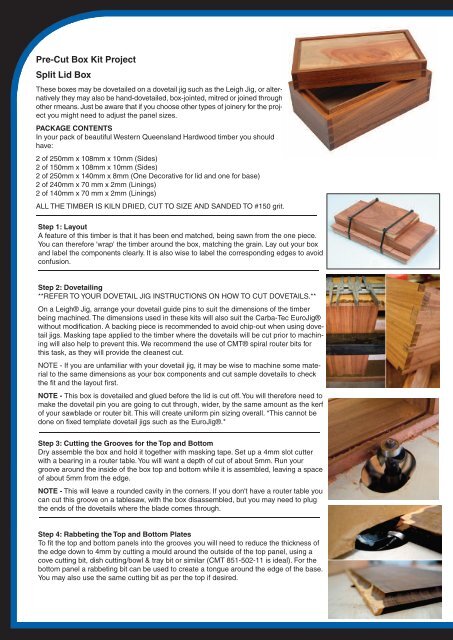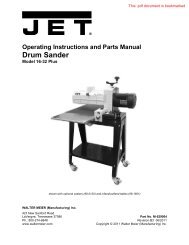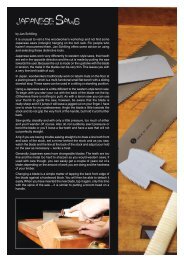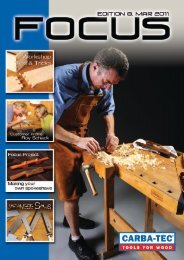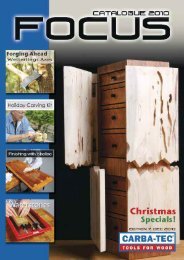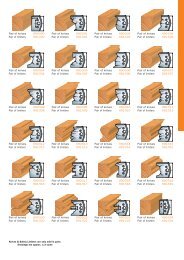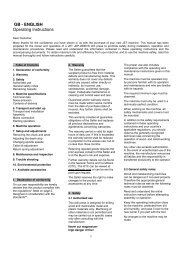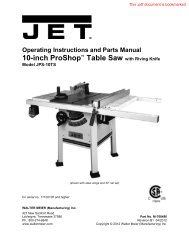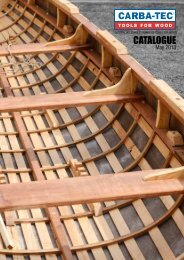You also want an ePaper? Increase the reach of your titles
YUMPU automatically turns print PDFs into web optimized ePapers that Google loves.
Pre-Cut Box Kit Project<br />
Split Lid Box<br />
These boxes may be dovetailed on a dovetail jig such as the Leigh Jig, or alternatively<br />
they may also be hand-dovetailed, box-jointed, mitred or joined through<br />
other rmeans. Just be aware that if you choose other types of joinery for the project<br />
you might need to adjust the panel sizes.<br />
PACKAGE CONTENTS<br />
In your pack of beautiful Western Queensland Hardwood timber you should<br />
have:<br />
2 of 250mm x 108mm x 10mm (Sides)<br />
2 of 150mm x 108mm x 10mm (Sides)<br />
2 of 250mm x 140mm x 8mm (One Decorative for lid and one for base)<br />
2 of 240mm x 70 mm x 2mm (Linings)<br />
2 of 140mm x 70 mm x 2mm (Linings)<br />
ALL THE TIMBER IS KILN DRIED, CUT TO SIZE AND SANDED TO #150 grit.<br />
Step 1: Layout<br />
A feature of this timber is that it has been end matched, being sawn from the one piece.<br />
You can therefore 'wrap' the timber around the box, matching the grain. Lay out your box<br />
and label the components clearly. It is also wise to label the corresponding edges to avoid<br />
confusion.<br />
Step 2: Dovetailing<br />
**REFER TO YOUR DOVETAIL JIG INSTRUCTIONS ON HOW TO CUT DOVETAILS.**<br />
On a Leigh® Jig, arrange your dovetail guide pins to suit the dimensions of the timber<br />
being machined. The dimensions used in these kits will also suit the <strong>Carba</strong>-<strong>Tec</strong> EuroJig®<br />
without modification. A backing piece is recommended to avoid chip-out when using dovetail<br />
jigs. Masking tape applied to the timber where the dovetails will be cut prior to machining<br />
will also help to prevent this. We recommend the use of CMT® spiral router bits for<br />
this task, as they will provide the cleanest cut.<br />
NOTE - If you are unfamiliar with your dovetail jig, it may be wise to machine some material<br />
to the same dimensions as your box components and cut sample dovetails to check<br />
the fit and the layout first.<br />
NOTE - This box is dovetailed and glued before the lid is cut off. You will therefore need to<br />
make the dovetail pin you are going to cut through, wider, by the same amount as the kerf<br />
of your sawblade or router bit. This will create uniform pin sizing overall. *This cannot be<br />
done on fixed template dovetail jigs such as the EuroJig®.*<br />
Step 3: Cutting the Grooves for the Top and Bottom<br />
Dry assemble the box and hold it together with masking tape. Set up a 4mm slot cutter<br />
with a bearing in a router table. You will want a depth of cut of about 5mm. Run your<br />
groove around the inside of the box top and bottom while it is assembled, leaving a space<br />
of about 5mm from the edge.<br />
NOTE - This will leave a rounded cavity in the corners. If you don't have a router table you<br />
can cut this groove on a tablesaw, with the box disassembled, but you may need to plug<br />
the ends of the dovetails where the blade comes through.<br />
Step 4: Rabbeting the Top and Bottom Plates<br />
To fit the top and bottom panels into the grooves you will need to reduce the thickness of<br />
the edge down to 4mm by cutting a mould around the outside of the top panel, using a<br />
cove cutting bit, dish cutting/bowl & tray bit or similar (CMT 851-502-11 is ideal). For the<br />
bottom panel a rabbeting bit can be used to create a tongue around the edge of the base.<br />
You may also use the same cutting bit as per the top if desired.


